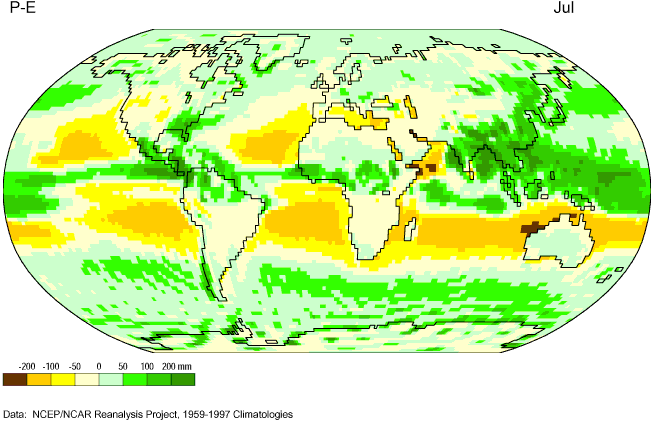Water is removed from the surface of the Earth to the atmosphere by two distinct mechanisms: evaporation and transpiration.
Evaporation can be defined as the process where liquid water is transformed into a gaseous state. Evaporation can only occur when water is available. It also requires that the humidity of the atmosphere be less than the evaporating surface (at 100% relative humidity there is no more evaporation). The evaporation process requires large amounts of energy. For example, the evaporation of one gram of water requires 600 calories of heat energy.
Transpiration is the process of water loss from plants through stomata. Stomata are small openings found on the underside of leaves that are connected to vascular plant tissues. In most plants, transpiration is a passive process largely controlled by the humidity of the atmospheric and the moisture content of the soil. Of the transpired water passing through a plant only 1% is used in the growth process. Transpiration also transports nutrients from the soil into the roots and carries them to the various cells of the plant and is used to keep tissues from becoming overheated. Some dry environment plants do have the ability to open and close their stomata. This adaptation is necessary to limit the loss of water from plant tissues. Without this adaptation these plants would not be able to survive under conditions of severe drought.
It is often difficult to distinguish between evaporation and transpiration. So we use a composite term evapotranspiration. The rate of evapotranspiration at any instant from the Earth's surface is controlled by four factors:
- Energy availability. The more energy available the greater the rate of evapotranspiration. It takes about 600 calories of heat energy to change 1 gram of liquid water into a gas.
- The humidity gradient away from the surface. The rate and quantity of water vapor entering into the atmosphere both become higher in drier air.
- The wind speed immediately above the surface. Many of us have observed that our gardens need more watering on windy days compared to calm days when temperatures are similar. This fact occurs because wind increases the potential for evapotranspiration. The process of evapotranspiration moves water vapor from ground or water surfaces to an adjacent shallow layer that is only a few centimeters thick. When this layer becomes saturated evapotranspiration stops. However, wind can remove this layer replacing it with drier air which increases the potential for evapotranspiration.
- Water availability. Evapotranspiration cannot occur
if water is not available.
On a global scale, most of the evapotranspiration of water on the Earth's surface occurs in the subtropical oceans (Figures 8i-1 and 8i-2). In these areas, high quantities of solar radiation provide the energy required to convert liquid water into a gas. Evapotranspiration generally exceeds precipitation on middle and high latitude landmass areas during the summer season. Once again, the greater availability of solar radiation during this time enhances the evapotranspiration process.

| Figure 8i-1: Precipitation minus evapotranspiration for an average January, 1959-1997. (Source of Original Modified Image: Climate Lab Section of the Environmental Change Research Group, Department of Geography, University of Oregon - Global Climate Animations). |

| Figure 8i-2: Precipitation minus evapotranspiration for an average July, 1959-1997. (Source of Original Modified Image: Climate Lab Section of the Environmental Change Research Group, Department of Geography, University of Oregon - Global Climate Animations). |